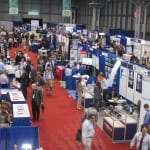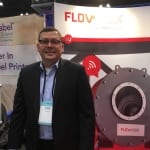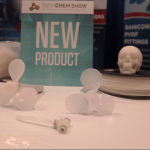Opportunities for improving processes abounded during the first day of the 2017 Chem Show, which opened yesterday at the Javits Center in New York. With a mix of best practice seminars, product presentations and exhibitor booths, the event’s first day provided plenty of insight for attendees.
Best practice seminars
The Chem Show’s educational program featured several talks on optimizing processes, including those on flow modeling software and the use of IIoT (industrial internet of things) based tools for asset management.
The potential benefits of using IIoT-enabled tools for asset management can extend from lowering energy costs to avoiding costly downtime by improving predictive maintenance. The benefits were discussed as part of a presentation from Tom Loudin, president of North American operations at Flowrox (Booth #443; www.flowrox.us). Loudin began by highlighting the the rapid growth of internet-connected devices (the number of internet-connected devices has ballooned from one million in 1995 to a projected 50 billion devices by 2020) and the influx of tech-savvy workers (1 billion “digital natives” are projected to enter the workforce over the next seven years) as a foundation for using IIoT-enabled technologies.
Loudin emphasized the concept of “connect for performance” as a way to uncover operational inefficiencies and operate smarter. Digital technologies, such as internet-connected sensors and cloud-based monitoring, can help plant operators gain real-time feedback on asset performance and allow operators to quickly identify and diagnose problems before costly failures occur. This can dramatically reduce unplanned downtime. Additionally, this can improve safety and lower maintenance costs. By placing a wealth of information in a user-friendly interface, process operators get early warnings of potential problems and can take quick corrective action, Loudin said.
Another tool to help increase reliability and reduce costs was presented by Dominik Fry, of the Hydraulic Institute (Booth #830; www.pumps.org) an association of pump-industry manufacturers. Fry discussed flow-modeling software available from the organization that can help users boost efficiency and reliability of their processes. There seems to be much room for improvement: Fry cited a study of 1,690 pumps at 20 plants that found the average efficiency was below 40%.
The modeling software allows users to build virtual systems and evaluate changes to help paint a clear picture of how the system will work. Fry stressed the importance of taking a systems approach to optimization, where pumps, valves, pipes and other equipment are considered together, rather than focusing on individual components.
Exhibitor talks
Other improvement and learning opportunities could be found in the Chem Show’s Equipment & Technology Showcase. For example, Howard Fisher, president of Nile Polymers, Inc. (Booth 808; www.nilepolymers.com) announced the availability of new filament materials for additive manufacturing (3D printing) made of polyvinylidene difluoride (PVDF), said to be an industry-first in the U.S.
Fisher explained that while some PVDF filaments have been produced by companies in Europe, Nile Polymers’ offerings are available at a lower price point and in a larger volume. The company has worked for the past year to optimize the filament manufacture technique using an off-the-shelf 3D printer, and will begin offering 1.75- and 2.85-mm filaments in the coming weeks.
PVDF holds several benefits for 3D printing that are not offered by traditionally used materials, including resistance to ultraviolet light and ionizing radiation, which can destroy other plastic grades. “PVDF actually crosslinks with ionizing radiation and becomes stronger,” explains Fisher. PVDF is also resistant to harsh chemicals, such as acids, caustics and solvents, making it suitable for 3-D-printed parts used in chemical processing and other industrial applications. Another advantage is that PVDF experiences no flame propagation, making the materials safer to handle in 3D-printing operations.
Furthermore, Fisher highlighted PVDF’s wide melt-processing window — said to be among the widest of all fluoropolymers — and noncorrosive behavior of PVDF, as well as the materials’ creep resistance and tolerance for deformation under strain. “Once other fluoropolymers are in the melt phase they can attack stainless steel, but that’s not a problem with PVDF,” Fisher says. PVDF’s compatibility with acrylics and adhesives is another important factor in ensuring a reliable 3D-printed products. Nile Polymers’ filaments are made from Kynar PVDF produced by Arkema (Colombes, France; www.arkema.com), making the filaments fully traceable for end users of 3D printed parts. Arkema recently announced a capacity expansion for Kynar PVDF at its production site in Kentucky.


